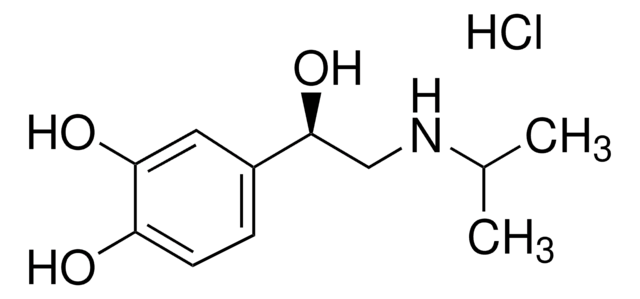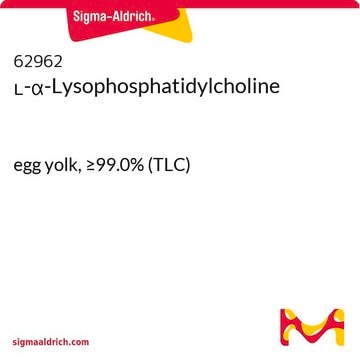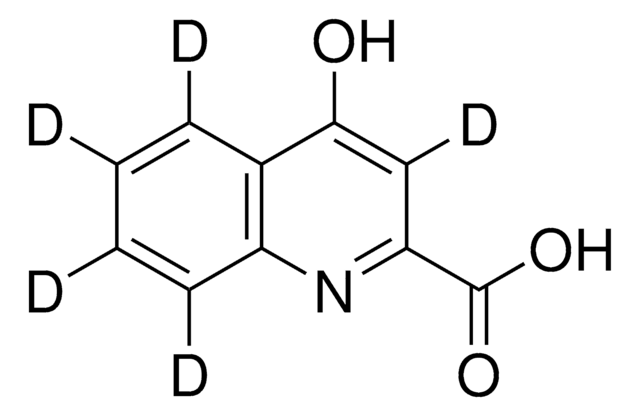L1381
L-α-Lysophosphatidylcholine from bovine brain
≥99%, Type V
Sinônimo(s):
1-Acyl-sn-glycero-3-phosphocholine, L-α-Lysolecithin
Faça loginpara ver os preços organizacionais e de contrato
About This Item
Produtos recomendados
descrição
zwitterionic
tipo
Type V
Ensaio
≥99%
tipo de lipídio
phospholipids
temperatura de armazenamento
−20°C
Descrição geral
L-α-Lysophosphatidylcholine is a major plasma lipid, derived from phosphatidylcholines that includes glycerol and sphingoid based lipids with one fatty acid. It is an important cell signaling molecule for G-protein coupled receptors.
Aplicação
L-α-Lysophosphatidylcholine from bovine brain has been used:
- to determine the dose-dependent high-mobility group box 1 (HMGB1) release in macrophage and monocyte cultures by production of lysophosphatidylcholine (LPC)
- for lysolecithin demyelination of mice brain tissue
- for demyelination of axons
Ações bioquímicas/fisiológicas
L-α-Lysophosphatidylcholine possess cytotoxic effects and is present at high level in ischemia and atherosclerotic aortas.
Lysophosphatidylcholine is a major component of oxidized low density lipoproteins, and has been implicated in various inflammatory reactions, including atherosclerosis. It is a degradation product of phosphatidylcholine by phospholipase A and has cytolytic properties. The product is used to demyelinate spinal neurons and study the processes underlying remyelination. It activates protein kinase C, p38 MAP kinase, p42 MAP Kinase, and the jun kinase (JNK) pathway, and stimulates transcription of c-jun. Lysophosphatidylcholine accumulates during cardiac ischemia and may induce arrhythmias by uncoupling gap junction communication, and increase ischemic damage by enhancing Na+ loading in cardiac myocytes. It also activates TREK1, TREK2 and TRAAK K+ channels.
Características e benefícios
This compound is featured on the Phospholipase D page of the Handbook of Receptor Classification and Signal Transduction. To browse other handbook pages, click here.
Outras notas
Contains primarily palmitic, stearic and oleic acids.
Código de classe de armazenamento
11 - Combustible Solids
Classe de risco de água (WGK)
WGK 3
Ponto de fulgor (°F)
Not applicable
Ponto de fulgor (°C)
Not applicable
Equipamento de proteção individual
Eyeshields, Gloves, type N95 (US)
Certificados de análise (COA)
Busque Certificados de análise (COA) digitando o Número do Lote do produto. Os números de lote e remessa podem ser encontrados no rótulo de um produto após a palavra “Lot” ou “Batch”.
Já possui este produto?
Encontre a documentação dos produtos que você adquiriu recentemente na biblioteca de documentos.
Os clientes também visualizaram
Metabolism and atherogenic disease association of lysophosphatidylcholine
Schmitz G and Ruebsaamen K
Atherosclerosis, 208(1), 10-18 (2010)
Human induced pluripotent stem cells differentiation into oligodendrocyte progenitors and transplantation in a rat model of optic chiasm demyelination
Pouya A, et al.
PLoS ONE, 6(11), e27925-e27925 (2011)
Suppression of HMGB1 release by stearoyl lysophosphatidylcholine:an additional mechanism for its therapeutic effects in experimental sepsis
Chen G, et al.
Journal of Lipid Research, 46(4), 623-627 (2005)
Characterization of plasma unsaturated lysophosphatidylcholines in human and rat
CROSET M, et al.
The Biochemical Journal, 345(1), 61-67 (2000)
Myelin regulatory factor drives remyelination in multiple sclerosis
Duncan GJ, et al.
Acta neuropathologica, 134(3), 403-422 (2017)
Nossa equipe de cientistas tem experiência em todas as áreas de pesquisa, incluindo Life Sciences, ciência de materiais, síntese química, cromatografia, química analítica e muitas outras.
Entre em contato com a assistência técnica











